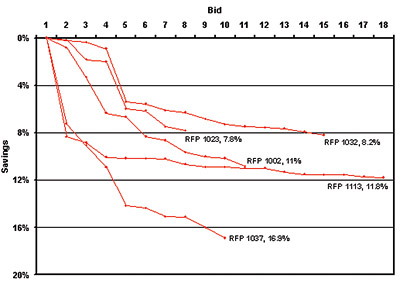
Online energy procurement services are not new: by early 2001, at least 27 firms were offering them. The few that survived the dotcom debacle several years ago now handle sales of billions of kWh and cubic feet of natural gas, making this option now a stable part of the competitive energy landscape.
The two largest (in kWh volume) retail energy auction services are World Energy (www.worldenergy.com) and Energy Window (www.energywindow.com. ach uses Web-based software to receive, portray, and compare bids from vendors while customers sit back and watch their pricing drop until a winner is declared.
Choosing An Auction Service
Rich Domaleski, CEO of World Energy, cautions that such services should not be confused with Web-based consulting firms that manually handle RFPs. "It's important for vendors to actually see each others' bids in real time. Otherwise, the competitive process is limited, and that last 10% of price squeezing may not happen."A variety of issues arise when choosing to use an online reverse auction service. At no point, for example, can a large customer hand off his due diligence requirements to a third party and expect no repercussions if the deal later has problems. Vendor financial strength, contract terms, and credit issues may still require close review outside the auction process.
Potential customers should look for these options and functions:
- Ability to pre-screen vendors to filter out those not acceptable before bidding.
- All vendors of interest to the customer use the auction service.
- Option to choose a bidder that did not offer the lowest bid.
- A process to provide any special conditions to vendors several weeks before bidding to ensure their pricing reflects compliance with those conditions.
- No limits on price structures (e.g., index, real time, curtailable) that can be bid.
- Use of interval data instead of only monthly data.
- No requirement to bundle any other services with the auction.
- Auction can cover all customer locations where deregulation has occurred.
- Customer energy and credit data is secure from competitors and others.
- Auction service is experienced with customers of comparable size, number of sites, locations, and other factors.
- Customer may speak to others using the auction service.
- Process is fully electronic, allowing easy accounting.
- Financial as well as physical energy products are open to auction.
Shortening The Procurement Cycle
One major advantage to such services is the short time involved to settle to a price. World Energy claims it needs only about two weeks from receiving authorization before it is ready to start its auction (though this may depend on how quickly utilities supply customer usage data). With recent energy price volatility in mind, the ability to quickly reach pricing may be just what's needed to keep a budget from going into the red.Costs and Savings
Unlike many energy consulting firms that charge endusers for procurement services, online transactions generally involve no upfront or direct costs. Depending on the auction firm, its services may be paid through a small adder to the vendor's price (typically a mill or less, e.g., $.001/kWh, depending on the number of accounts and activities involved), paid by the winning vendor to the auction firm.While no side-by-side studies have been performed to show a differential between online auctions and standard RFP procurement methods, savings claims by auction services and some customers range from 3% to 9%, relative to standard offer pricing (i.e., simply buying from a utility).
An unbiased presentation by a major governmental client using an online auction for power procurement may be found at www.energy2003.ee.doe.gov/topic-navigating.htm#3. ES



